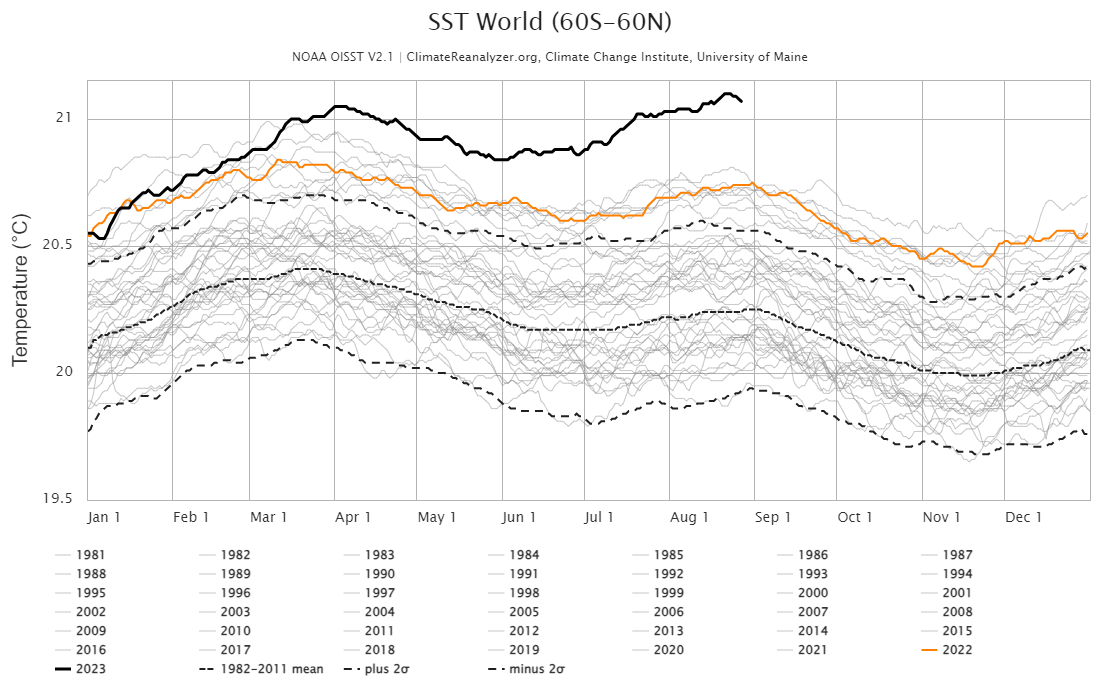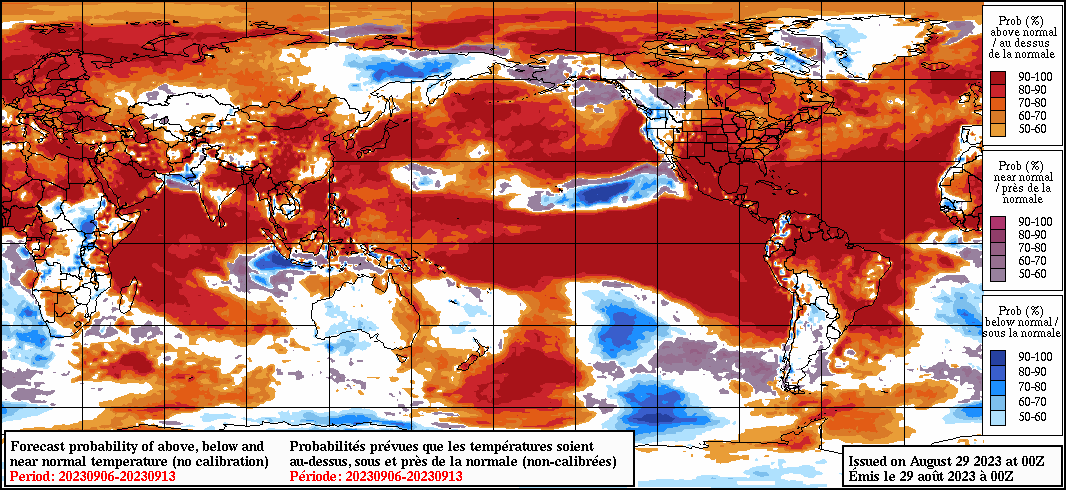From record-shattering heatwaves to unprecedented forest fires, the summer of 2023 is one for the record books — and it’s still only August.

Last month was the hottest in recorded history, as firefighters responded to hundreds of wildfires in Canada, tourists grappled with extreme heat in Europe, and residents of Phoenix, Arizona endured an entire month of temperatures that went beyond 43 degrees Celsius each day.
It’s not just weather extremes on land that are a cause for concern.
Giant stretches of the world’s oceans are experiencing unheard-of hot temperatures, alarming oceanographers, coral researchers and atmospheric scientists the world over.
Oceans have been absorbing 90 per cent of the excess heat that gets emitted into the atmosphere from the buildup of greenhouse gases, including those that are the result of industrial-scale burning of fossil fuels by humans to power the world economy.
But all that heat energy, absorbed by vast expanses of water, can eventually make its way into the atmosphere, accelerating the vicious cycle of planetary heating — and leading to more weather extremes, including more intense fires, fiercer storms and more gruelling heatwaves.
“This is exactly the kind of thing that leads to stronger rain events, stronger storms,” says Ted Scambos, a senior research scientist at the University of Colorado Boulder. “Not necessarily more hurricanes or more storms, but very often stronger storms and bigger rain events when they occur.”
The oceans, in other words, have been doing a lot of the heavy lifting in terms of mitigating the escalating crisis of global heating. But there is only so much heat they can absorb.
“The atmosphere is intimately linked to the ocean,” says John Clague, a professor emeritus of earth sciences at Simon Fraser University. “If you have a warming ocean, in general, your atmosphere is warmer as well.”
Like ‘taking a bath’ in the Atlantic
The ‘maritime’ heatwaves scientists have been observing this year have been literally off the charts.
The water temperature off the coast of South Florida peaked at around 38 degrees Celsius this summer. Swimmers described it like ‘taking a bath.’
“These extremes are off scale from any sort of forecast,” says Clague, adding to the growing chorus of experts expressing shock and alarm at the state of the world’s oceans.
The North Atlantic has similarly been off the charts, with temperatures running six to seven degrees Celsius above normal, which is unheard of.
“That is just uncharted territory for ocean temperatures,” says Jennifer Francis, a senior scientist at the Woodwell Climate Research Center in Massachusetts, who, like her peers, is alarmed by what is happening.
“The North Atlantic right now is literally running a fever.”
Then there is a giant blob of warm water in the Pacific Ocean, off the west coast of North America, another area of concern.
“All of these globs of hot water around the global oceans have been causing the atmosphere to be extra warm,” Francis explains.
The alarming trend prompted UN Secretary-General Antonio Guterres to say that “climate change is here. It is terrifying. And it is just the beginning. The era of global warming has ended; the era of global boiling has arrived.”
El Niño
Adding to the concerns about excessive global heat is El Niño.
It’s a naturally occurring weather phenomenon that is associated with warmer waters in the Pacific Ocean off the coast of Peru and Ecuador. El Niño, or ‘Christ child,’ was the name coined by fishermen who noticed warmer waters around Christmastime. The weather anomaly results in warmer and wetter conditions in the winter months, especially along the west coast of North America.
El Niño occurs when winds blowing from South America to Southeast Asia across the Pacific weaken or start moving the other way. This anomaly results in warmer-than-normal waters building up off South America, as captured in this image, and leading to an overall pattern of global warming.
The El Niño pattern has been building since the earlier part of this year. However, its greatest impacts will likely start to be felt the strongest beginning in late fall or over the winter, when experts expect more records to start falling.
Climate scientists are especially concerned about this year’s El Niño cycle because the planet is already overheated from all the carbon dioxide that humans have emitted into the atmosphere over the past two centuries, but especially since the middle of the 20th century.
Top that heating off with El Niño-fueled warming — which acts as a kind of planetary heater — and next year could see even more weather records shattered.
“When we’re in an El Niño phase,” says Francis, “a lot of that heat in the ocean gets put into the atmosphere.”
“It’s just pushing an already pretty concerning situation heat-wise over the edge.”
- Gardeners need to watch out for these 2 worms in Ontario. Here’s why
- Talks conclude over a global plastic pollution treaty. What to know
- Satellite built by N.B. students not responding a week after entering Earth’s orbit
- T. Rex an intelligent tool-user and culture-builder? Not so fast, says new U of A research








Comments